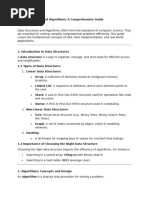Data_Structures_&_Algorithms_Extended
Uploaded by
Lin CongData_Structures_&_Algorithms_Extended
Uploaded by
Lin CongData Structures & Algorithms
Introduction to Data Structures & Algorithms
Data structures such as arrays, linked lists, stacks, queues, trees, and graphs are fundamental in
programming.
Sorting algorithms include QuickSort, MergeSort, and HeapSort.
Searching techniques include binary search and depth-first search (DFS) and breadth-first search
(BFS) for graphs.
Big-O notation is used to analyze algorithm efficiency.
Hashing techniques allow efficient data retrieval with minimal lookup time.
Stack and Queue: Stacks follow LIFO, Queues follow FIFO.
Tree structures include Binary Search Trees, AVL trees, and Red-Black Trees.
Graph algorithms like Dijkstra's Algorithm and Kruskal's Algorithm help in pathfinding and network
flows.
Dynamic Programming optimizes recursive problems by storing intermediate results.
Greedy algorithms solve problems step-by-step with local optimizations.
Recursion vs Iteration: Recursive solutions are often simpler but use more memory.
Graph representations include adjacency matrices and adjacency lists.
Introduction to Data Structures & Algorithms
Data structures such as arrays, linked lists, stacks, queues, trees, and graphs are fundamental in
programming.
Sorting algorithms include QuickSort, MergeSort, and HeapSort.
Searching techniques include binary search and depth-first search (DFS) and breadth-first search
(BFS) for graphs.
Big-O notation is used to analyze algorithm efficiency.
Hashing techniques allow efficient data retrieval with minimal lookup time.
Stack and Queue: Stacks follow LIFO, Queues follow FIFO.
Tree structures include Binary Search Trees, AVL trees, and Red-Black Trees.
Graph algorithms like Dijkstra's Algorithm and Kruskal's Algorithm help in pathfinding and network
flows.
Dynamic Programming optimizes recursive problems by storing intermediate results.
Greedy algorithms solve problems step-by-step with local optimizations.
Recursion vs Iteration: Recursive solutions are often simpler but use more memory.
Graph representations include adjacency matrices and adjacency lists.
You might also like
- Data Structures & Algorithms _ Faisal's Notes (1)No ratings yetData Structures & Algorithms _ Faisal's Notes (1)3 pages
- Mastering Data Structures and Algorithms 64ea400bNo ratings yetMastering Data Structures and Algorithms 64ea400b179 pages
- Data Structures and Algorithms With Python 100 Coding Q A Code of Code by Cakal Yasin 1100% (2)Data Structures and Algorithms With Python 100 Coding Q A Code of Code by Cakal Yasin 1327 pages
- Data - Structures - and - Algorithms - Large 2024 New VesionNo ratings yetData - Structures - and - Algorithms - Large 2024 New Vesion20 pages
- Introduction Of Data Structure And AlgorithmsNo ratings yetIntroduction Of Data Structure And Algorithms11 pages
- BIS123 - Data Structures and Algorithms Course OutlineNo ratings yetBIS123 - Data Structures and Algorithms Course Outline2 pages
- Comprehensive Guide to Data Structures and AlgorithmsNo ratings yetComprehensive Guide to Data Structures and Algorithms4 pages
- Data Structure and Algorithms IntroductionNo ratings yetData Structure and Algorithms Introduction2 pages
- Chapter 1 Introduction to datastructure and algorithmNo ratings yetChapter 1 Introduction to datastructure and algorithm10 pages
- CNS - Data Structures & Algorithms - IntroductionNo ratings yetCNS - Data Structures & Algorithms - Introduction25 pages
- Mastering Data Structures and Algorithms with Python: Unlock the Secrets of Expert-Level SkillsFrom EverandMastering Data Structures and Algorithms with Python: Unlock the Secrets of Expert-Level SkillsNo ratings yet
- Yeates 2024 Animal Behaviour and Welfare Research a One Health PerspectiveNo ratings yetYeates 2024 Animal Behaviour and Welfare Research a One Health Perspective22 pages

































































